pieter van bogaert
pieter@amarona.be
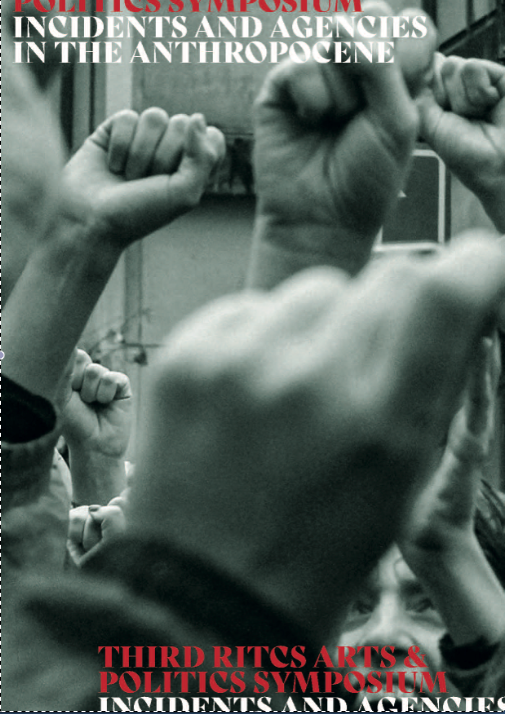
Before and After
The art of the non-event
Talk for Third RITCS Arts & Politics Symposium, 2019

Fifteen years ago I made a book with artists Els Opsomer and Herman Asselberghs after a ten day visit to Ramallah, Jerusalem and Gaza. The title of the book and of the exhibition that came with it was Time Suspended. Dieter (Lesage, who invited me for this talk) was so kind to say a few words for the book presentation. One of the things he noticed was the absence of maps in our book. And it is true: there are no maps in our book. Or better: were. Because Harrison, the graphic designer who made the flyer for the book presentation (but did not design the book), noticed the same thing as Dieter when leafing through our book: there is no map. So he decided to use a map of Israel and the territories for the flyer that could also be used as a bookmark afterwards. So, all of a sudden, there was a map in our book.
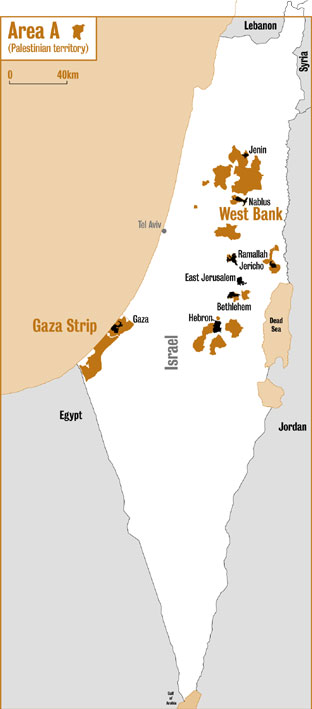
Dieter and Harrison were right, of course. A book on the issue of Palestine should have a map. Every book on the issue of Palestine has a map. Impossible to understand the situation without a map. But the strangest thing is that Palestinians had no maps of their own. They did not have any maps to take to the peace talks, during the 1990’s, either. They relied on Israeli maps to guide them through the talks. Which put them in the weaker position, as it soon became clear. Shortly before Dieter and Harrison noticed it, the Israeli Human Rights organisation B’Tselem decided to produce alternative maps to counter that situation. Countermaps. The person who worked on the maps and one of the first to publish them in books on the region was a young Israeli architect. His name is Eyal Weizman. The map used by Harrison for the flyer is based on his research.

Weizman soon realised that his was a temporary map. That the borders between the different zones on the map (divided in area’s A, B and C – under Palestinian, shared Palestinian and Israeli, and full Israeli control) were shifting constantly. That his was a map that should be seen in time. He added a new dimension to the map – the timely aspect: the temporary.
The title of this lecture is Before and After. That too has to do with time. Travelling to the occupied territories in 2002 has been a life changing experience for me personally. There clearly is a time before and a time after that journey. It has to do with changing views: on politics, on the region, on globalization, on colonialism (and post-colonialism and neo-colonialism). And it has to do with media: the stories and images I left with from here and the situation as I experienced it over there.
The subtitle of my lecture is the art of the non-event. You have to know that little happened when I was in Ramallah. That all has to do with the second intifada, the Palestinian uprising that started two years earlier, in the year 2000, after a provocative visit of Ariel Sharon to the temple mount. Most cities on the West Bank, if not all, and Ramallah was the exception here, were closed, under curfew. But every day somebody promised us to take us to another town the next day. But it never happened. So what we did was wait until something would happen. And while we waited we met with filmmakers, artists, writers who told us about everyday life under the occupation. We spent time together and learned about the importance of time under the occupation. How things may seem permanent after thirty-five years of occupation (I am still talking about 2002), but always remain temporary. About the importance of this temporariness for the Palestinians, still carrying the keys of the houses they left in 1948, waiting to go back when the time will come. But for the Israeli’s too – and to understand that you have to read Weizman – this state of temporariness is important. It is, after all, they who created it and still continue creating it. It allows them to master a permanent temporary state of emergency, a state of exception, where laws count in a different way (or not at all).
Before and After Ramallah, for me, coincides more or less with before and after Weizman. And that is the reason why I am here today. Weizman, after all, is one of the key figures – the founding director and principal investigator – of Forensic Architecture, the research group at Goldsmiths College in London that (and this I quote from the website) “produces and presents architectural evidence within legal and political processes”. Forensic Architecture started working in 2010. But before that, Weizman already used architecture to understand the political situation of the occupied territories in Israel. So that is what I will do here today. I will talk about what happened before and after Forensic Architecture, retracing the work of Eyal Weizman before he founded the group, and I will also say a few words about what happened after its founding. I will connect this to my own experiences before and after my first visit to Ramallah, Jerusalem and Gaza in 2002 and more specifically with my meeting with Palestinian artist Emily Jacir when I was there and whose work, just like Weizman’s, I continued following after.
It is only after my return from Ramallah, while reading A Civilian Occupation,

the book edited by Eyal Weizman and Rafi Segal in 2003, that I started to understand what I saw when I was there. Weizman and Segal, after winning the architectural competition organized by the Israel Association of United Architects, were invited to organise an exhibition in Berlin and proposed to examine the role of Israeli architecture in the Middle East conflict. How architecture is used as a political and even military tool in the Israeli occupation of the West Bank. The Israel Association of United Architects didn’t like the idea and tried to prevent the exhibition by destroying the 5000 copies of the catalogue. This is the second edition of the catalogue, co-published by Babel (Tel Aviv) and Verso (London & New York). The same material returned in an extended version in Territories, this book,
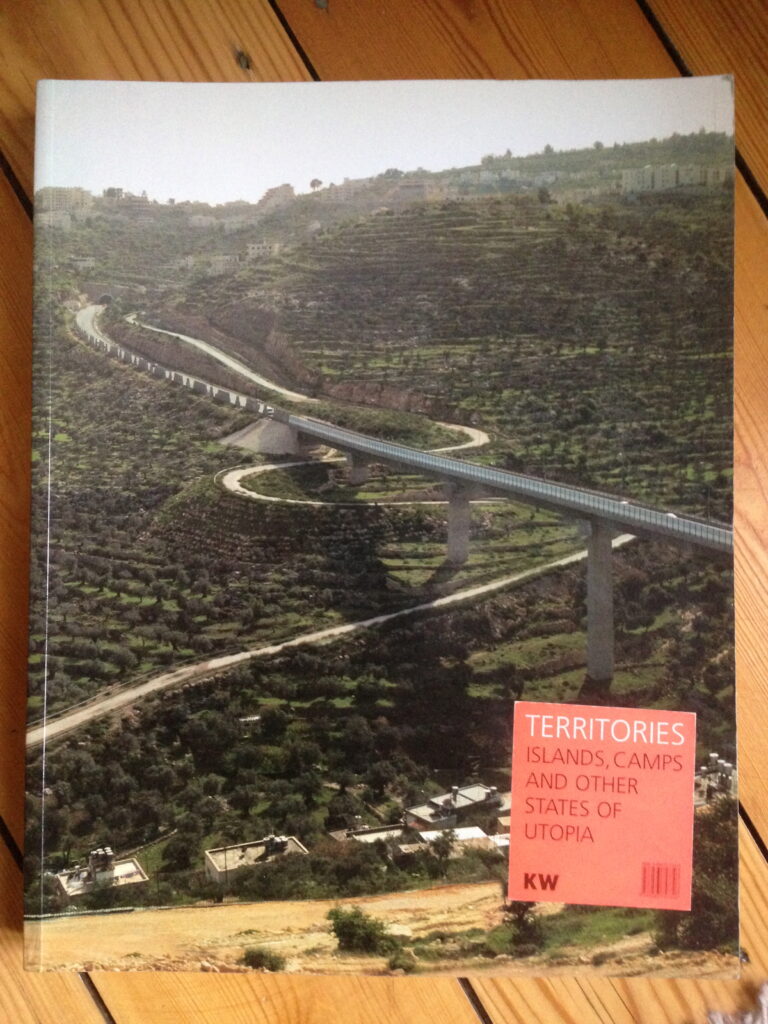
made with Anselm Franke, who was also, with Weizman, curator of Forensis, the exhibition on Forensic Architecture at Haus der Kulturen der Welt in 2014 – and those who followed the seminar with Dieter have read parts of the publication that came out with that exhibition.
With books and exhibitions as A Civilian Occupation and Territories, Weizman (and Segal, and Franke and many other architects, artists, writers and curators he worked with) learned me not only to understand the settlements we passed by every night, walking from our favourite bar where we spent our evenings in Ramallah to our hotel. He learned me to understand how architecture is being used as a tool, turning the military occupation into an occupation by civilians. He also learned to think space differently. Do not look at a map, or a landscape, or a space as something that stretches out horizontally, but – in order to understand the Israeli occupation – one has to learn also to think space vertically. Again, Weizman added another dimension.
Thinking vertically starts with the places where the settlements are built: on the mountaintops.
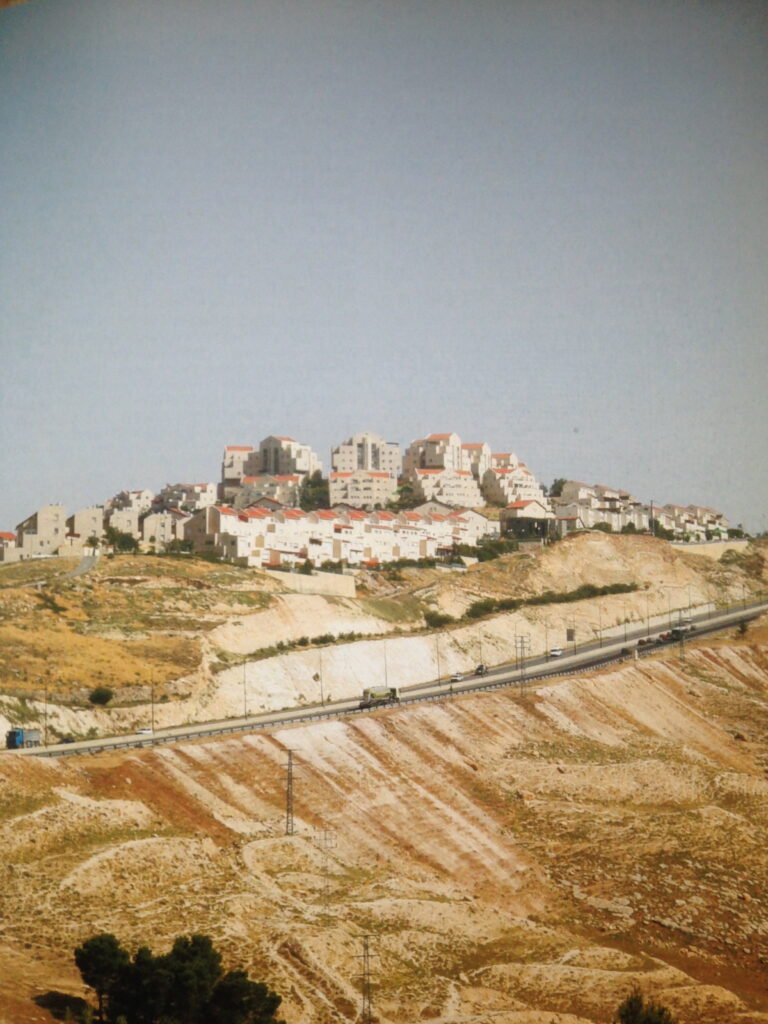
That is a vertical move towards the most barren places on the West Bank and therefore easy to occupy: Palestinians don’t live there. They prefer to live on the slopes going down towards the green line (the 1967 border between Israel and the West Bank), where they can cultivate the fertile grounds. By building on the mountaintops, the settlements are visible from afar (emphasising the affirmative state) and have a good view on the surroundings (to execute control). One of the consequences is that the settlements become islands surrounded by Palestinian fields and villages. To connect them with the Israeli main land, the settlers need bypass roads that lead over or under the Palestinian land using bridges or tunnels. That is what shows the cover of the Territories catalogue. That is what you see when you interpret space horizontally. But what Weizman makes clear by looking vertically, is that the Palestinians only have authority on the surface of area’s A and B, while the air above and the ground underneath the surface remains under Israeli control. That is not only interesting to build bridges and tunnels, going over and under the ground, but more so to control the water resources under the surface and the airspace above for goods and data. The same thing happens on the other side. In Gaza (which, as you probably know, is the largest open air prison in the world, keeping nearly 2 million Palestinians under captivity) tunnels are built by Palestinians under the border with Egypt, displacing the actual border under the surface, or: Egypt starts not on the border above, on the surface, but in the basement below, where you enter the tunnel. And also President Clinton believed in a vertical solution to the problem of partitioning the Temple Mount. Palestinians would get the Harram a Sharif and the mosques and Israeli’s would control the archaeology underneath with one and a half meters of UN possession in between.
This three-dimensional way of thinking a territory is where architecture, or the interpretation of space, becomes an ally for the military. The most perverse effect is that no longer the settlements are islands on the West Bank. On the contrary. The settlements reverse the situation and turn the Palestinian towns and villages into islands. The occupation turned the West Bank into a Swiss cheese: Israel takes the cheese and leaves the holes for the Palestinians.
I did not see any of all this while I was in Ramallah. I waited a lot while I was there. I talked and listened a lot. And I learned a lot about everyday life under the occupation. It took me quite some time to really understand what I had seen. And it took even longer until I could bring everything together under one common nominator: that of the non-event. To understand that, I would like to take you to an exhibition with works by Palestinian artist Emily Jacir at the Whitechapel Gallery in London, in 2015.
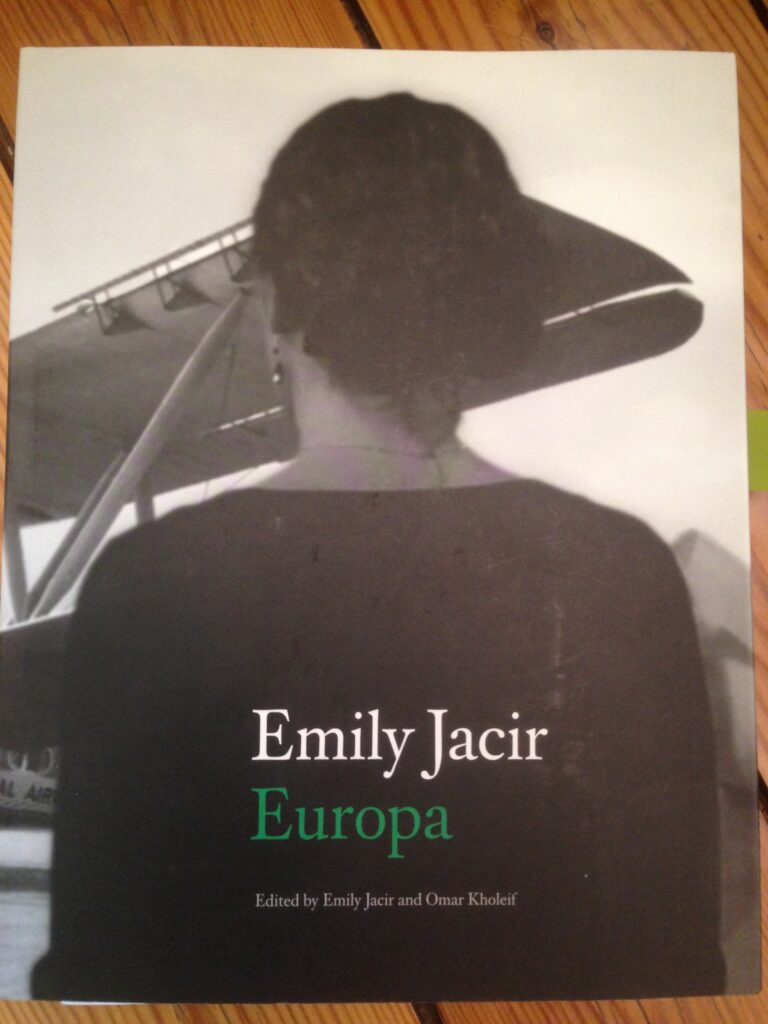
I met Emily in Ramallah in 2002. She guided us around the city and took us to meet her friends artists. She introduced me to the reality as it is experienced every day by the Palestinians. She told me about the project she was working on at the time, in 2002: Where we come from / (im)mobility. The project deals with life under the occupation and more specifically with the different passports of the different Palestinians on the West Bank, in Jerusalem, in Israel or in Gaza. Where we come from is a project about the dreams, the wishes, the desires of the Palestinians; about what they would do if they could travel – with or without a passport – to the other side. With her American passport, Emily can go to places that are out of reach for her fellow Palestinians. And that is what she does for them. She asks Palestinians in the occupied territories what they would like her to do in their place on the other side of the border. She executes these little tasks. For instance: in Haifa, climb Mount Carmel and look from there to the Mediterranean.
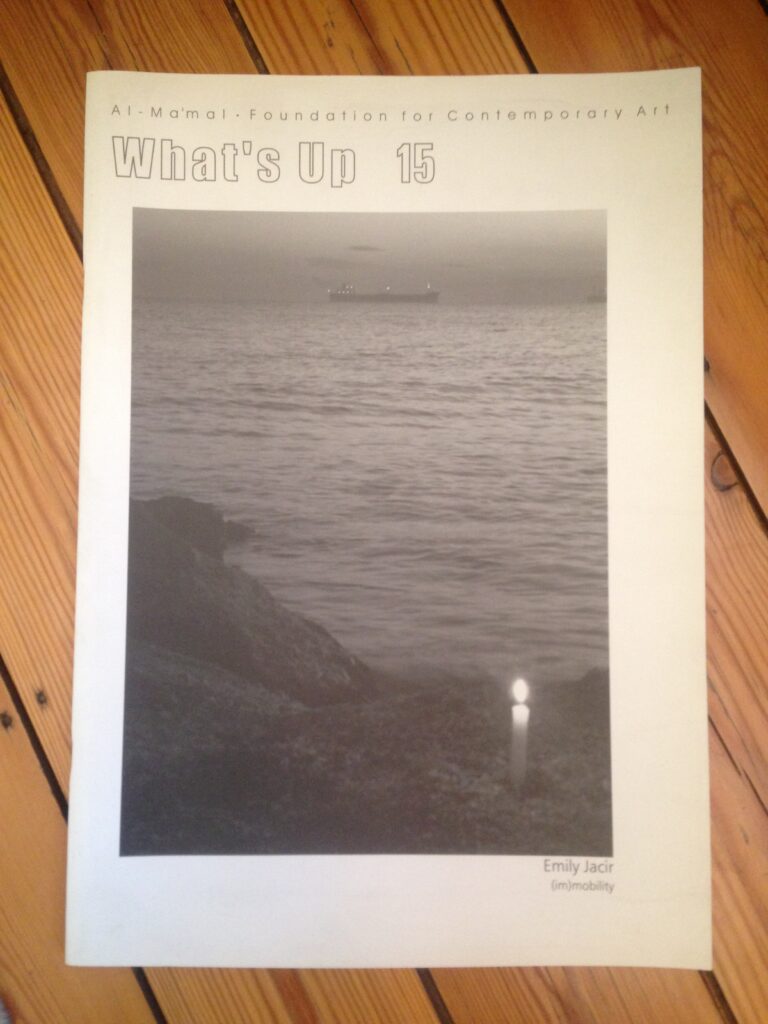
Light candles in the church of the Holly Sepulchre in Jerusalem and then walk to the Musrara bakery to buy Ka’ek and falafel and have it for dinner with mint tea. Go to Haifa and play football with the first Palestinian boy you meet in the street. Walk through the streets of Nazareth. Or, in Gaza, visit my mother, kiss her and tell her this is from her son. These are what I would call non-events. Emily Jacir creates displaced events. Events that couldn’t take place. She executes, realises stories and dreams of other Palestinians. She embodies them.
Here is an image that summarises the idea of the non-event.
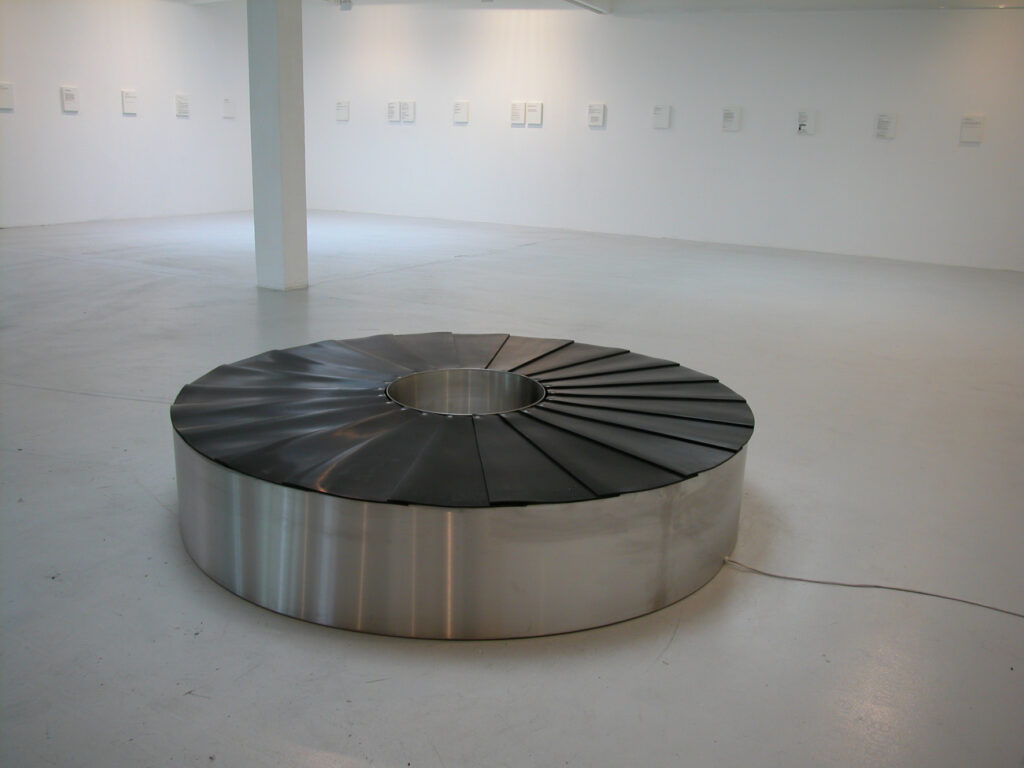
The name of the work is Embrace. In the exhibition at Whitechapel she installed a transportation belt like the ones we all know for our luggage in the airport. Only, this one is very short and turns in tiny circles, without any luggage. That is the image I often go back to when I think of the non-event. It shows a movement that goes nowhere. A movement that moves nothing, unless itself.
These unmoving movements help to understand the situation in the occupied territories of Palestine. These are unavoidable movements. Unstoppable. The movements under the occupation. Uncontrollable. These are the movements, guided by the memories, the dreams, the stories and the desires of the Palestinians who left their country in 1948. Of the children of these Palestinians and of the children of the children of these Palestinians. Of the Palestinians who today live in the refugee camps in Gaza, on the West Bank or in the surrounding countries – Jordan, Syria, Lebanon, Egypt. Of the Palestinians who still carry the keys of the houses left by their families in 1948. The Palestinians who refuse to accept their situation as something definite. The temporary status of their situation allows them to dream of a possible return. In those dreams there is something of a different reality. An alternative reality that keeps the Palestinians in movement, even if they have nowhere to go.
Emily Jacir’s is an art of displacement. She displaces herself into the situation of the Palestinians she shares her life with in the occupied territories. She displaces herself into historical situations. Like when she plays the role of Amelia Earhart,
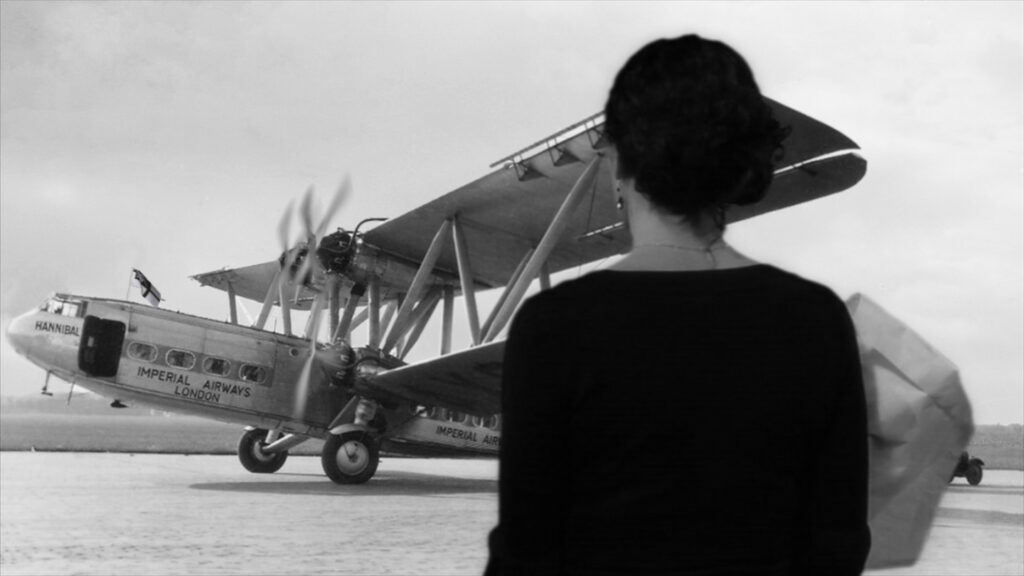
the American pilot who disappeared during a transatlantic flight in the 1930’s, in her own film Lydda Airport. Jacir takes the role of the female pilot, but also – turning this into a double displacement – of the person who is waiting for her arrival at the airport. An arrival that will never happen. A non-event. Lydda Airport later became Lod International Airport and today is known as Ben Gurion Airport, named after the first prime minister of Israel. Or how things shift slowly in time: without really moving a Palestinian airport becomes Israeli. For Entry denied (A concert in Jerusalem)
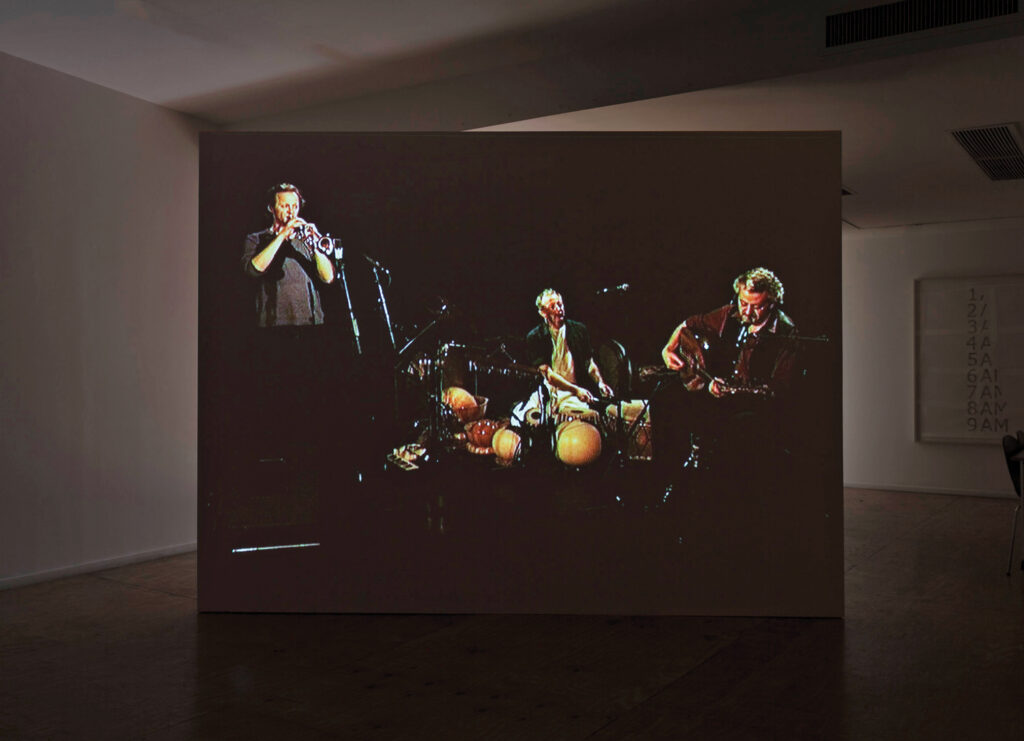
she organises – displaces – a concert in Vienna that never happened in Jerusalem because one of the musicians could not enter the country. Or, in Linz Diary,

she lets herself be filmed by a webcam on the central place of the Austrian city of Linz.
The webcam, or the camera that nobody films with: that is of course the pinnacle of the non-event. This fully automatic machine that makes continuously images that hardly anybody is interested in. These are the images in which rarely something happens. And still, every day, thousands, if not millions of these images are produced. Not only by the webcam of course, but also by surveillance camera’s or by the growing amount of camera’s on satellites orbiting around the world. And these are precisely the images used by Eyal Weizman in his work with Forensic Architecture.
Time Suspended, the book and exhibition after my first visit to the occupied territories, has always been, from the very beginning, a work about media, about what happens here and what happens elsewhere. And that idea of media will become always more important for Weizman, the closer he gets to Forensic Architecture and the more Forensic Architecture becomes an interdisciplinary project, not only involving architects, but also sound artists, media artists or writers. Time Suspended was our alternative for what we found in the media that are focused on the spectacular, on the highly visible events. Our work in response dealt with the unspectacular, with what happens in between the images, imperceptible, hardly visible. That too is something I recognise in the work of Eyal Weizman: Forensic Architecture is an alternative for the media, operating in an image-space where different kinds of images – often very unspectacular – are brought together, forming a totally new reality. Their resources are satellite images, amateur video’s, or images from YouTube: the images that hardly anybody wants to see, occasionally combined with images from the major news networks.
I’ve been following the work of Eyal Weizman ever since we finished our book and exhibition. And doing that, I noticed how each of his books contains the seeds for the following book.
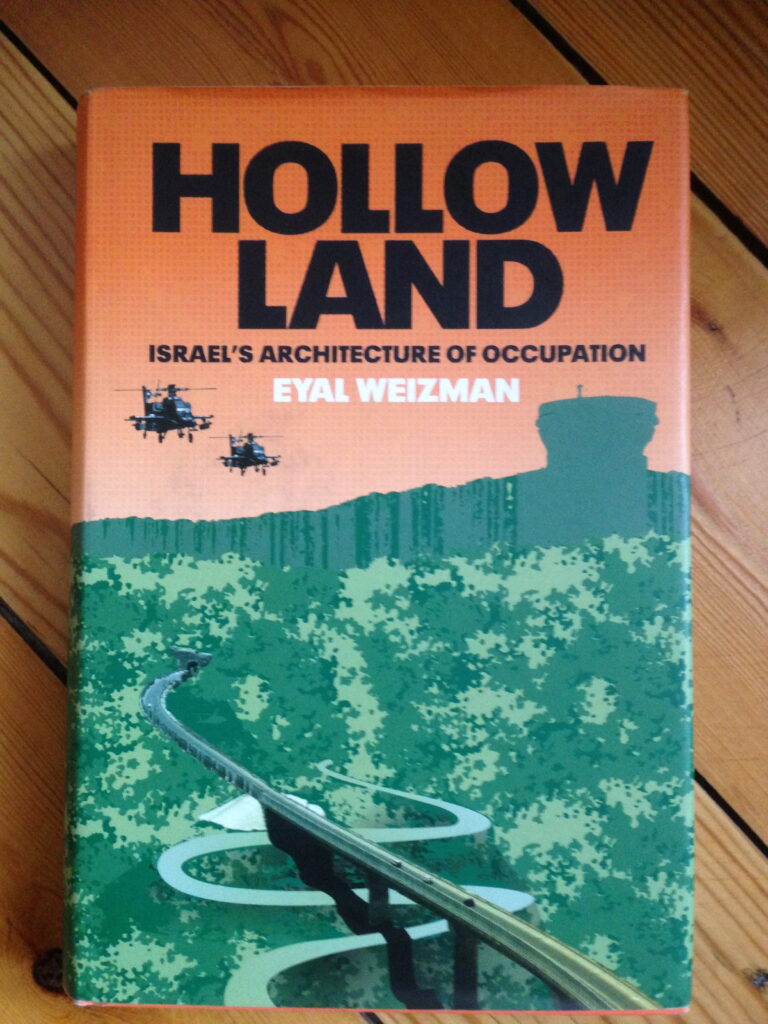
Hollow Land, as you will notice on the cover, goes further into the material of Territories. Indeed, it continues where Territories ends: the military operation as urban planning, with the case of the war against the urban guerrilla in the Jenin refugee camp on the West Bank. There, Israeli soldiers, instead of moving through the streets of the camp, move through the walls of the houses.
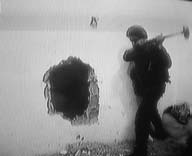


The urban warfare in Jenin in 2002 is closely watched by the American army and put in practice during their invasion of Bagdad in 2003. This technique of urban warfare comes as a prequel, a laboratory for the war in Bagdad in 2003.
That Weizman’s research starts in Israel and the occupied territories is important. But very quickly it takes him further to other places in time and space – like here, from Jenin to Bagdad. A similar displacement was already part of his account of the settlements on the hilltops of the West Bank as fortresses; settlements that were for a large part installed in the 1980’s, the time of the gated communities in the United States of Ronald Reagan. But he also sees a reversal of the biblical settlements that moved from the hilltops to the plains; or a similarity between the settlements on the hilltops today and the settlements of the crusaders that came to conquer the land in the Middle Ages.
The displacements in his research are not only in time and space, but also between disciplines: from the military to philosophy for instance. One of the most striking moments in Hollow Land is when he writes about the philosophical inspiration for the urban warfare in Jenin. In the terminology used by the IDF he finds references towards the work of French philosophers Gilles Deleuze and Félix Guattari. When Israeli soldiers walk through the walls of the houses in the camps, instead of using streets, doors, windows, corridors, they talk about “smoothing out space”: a terminology they get from Mille Plateaux,
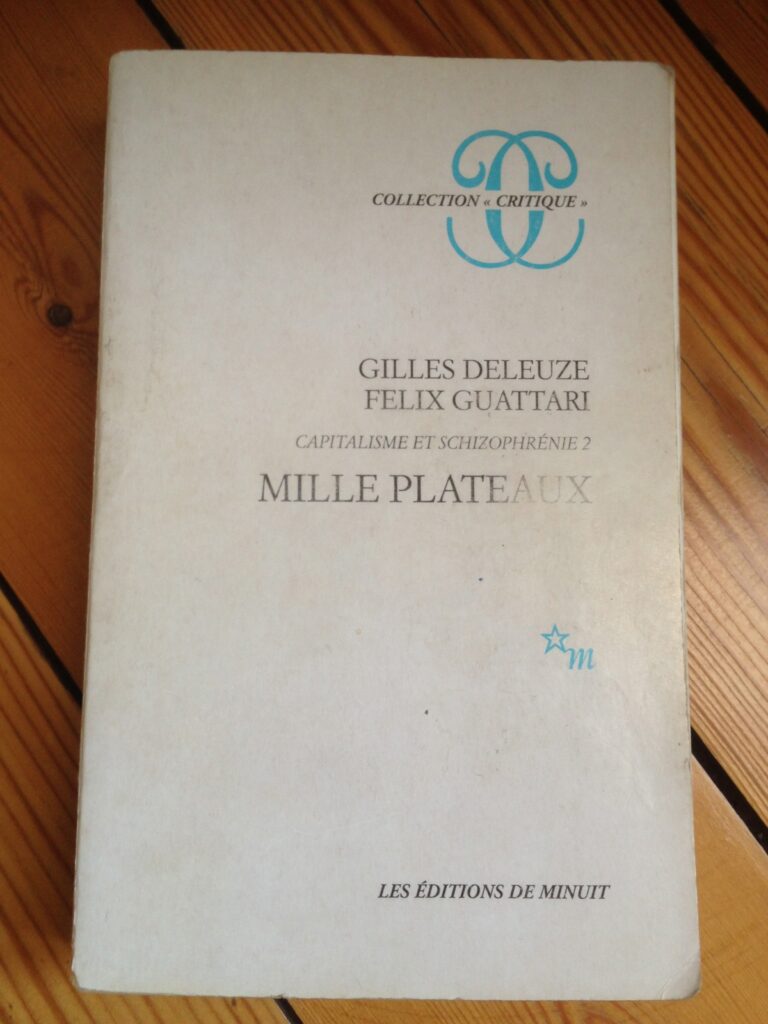
the book where Deleuze and Guattari make the distinction between striated space (geometrical, solid, sedentary) and smooth space (flexible, shifting, nomadic). The IDF uses terms like swarming and talk about war machines or even bodies without organs: literary references from the same book. It inspires them to go for the unexpected, the unanticipated (don’t use doors, windows, corridors, but go through the walls instead). The reason for that is that the IDF, just like Forensic Architecture of course, is an interdisciplinary organisation. Every Israeli citizen, man or woman, has to do military service. Therefore, the IDF has recruits from every layer of the population. Philosophers too go to the army and bring their concepts and knowledge along the way…
Hollow Land ends with the problem of the lesser evil: the moderation and minimization of violence as a mechanism of government and control. The Least of All Possible Evils,
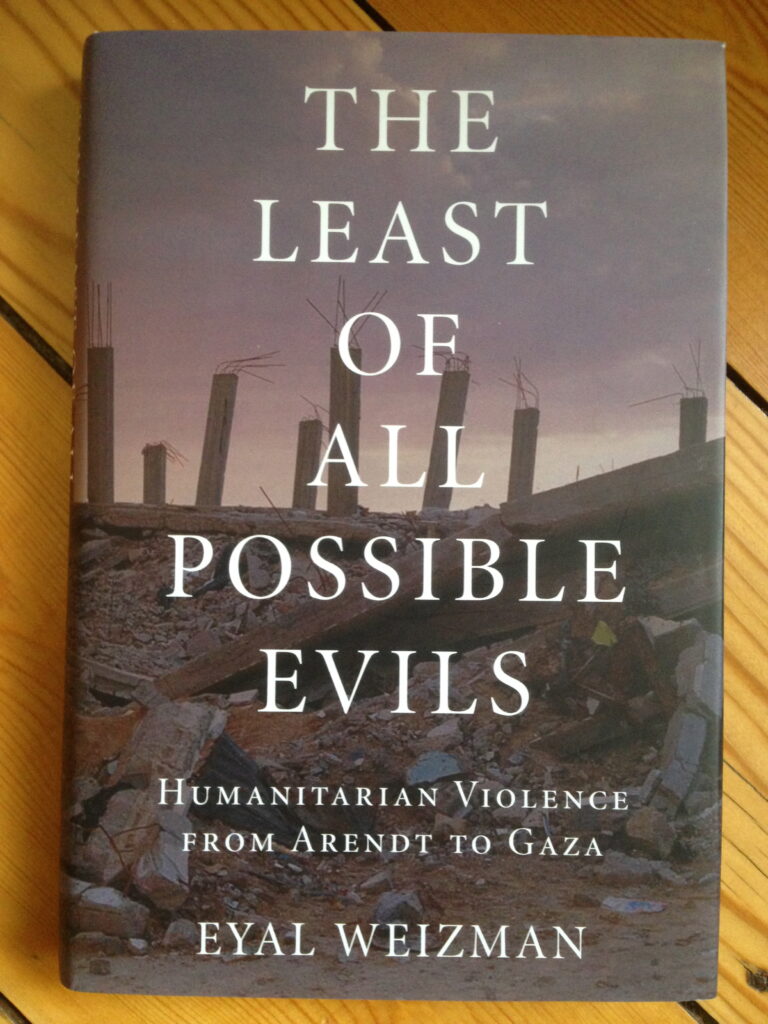
the book that Weizman published in 2011, goes further into this problem and its political consequences. Investigating the humanitarian calculations in new forms of contemporary war, he elaborates on the foundations of what Forensic Architecture started working on in 2009, two years before the publication of this book. Here it becomes clear how Forensic Architecture reverses the forensic gaze to investigate state agencies, police, military that usually monopolize it. Forensic Architecture explores the threshold of detectability, of what is barely visible, as you can read in the subtitle of his book titled Forensic Architecture that he published in 2017.
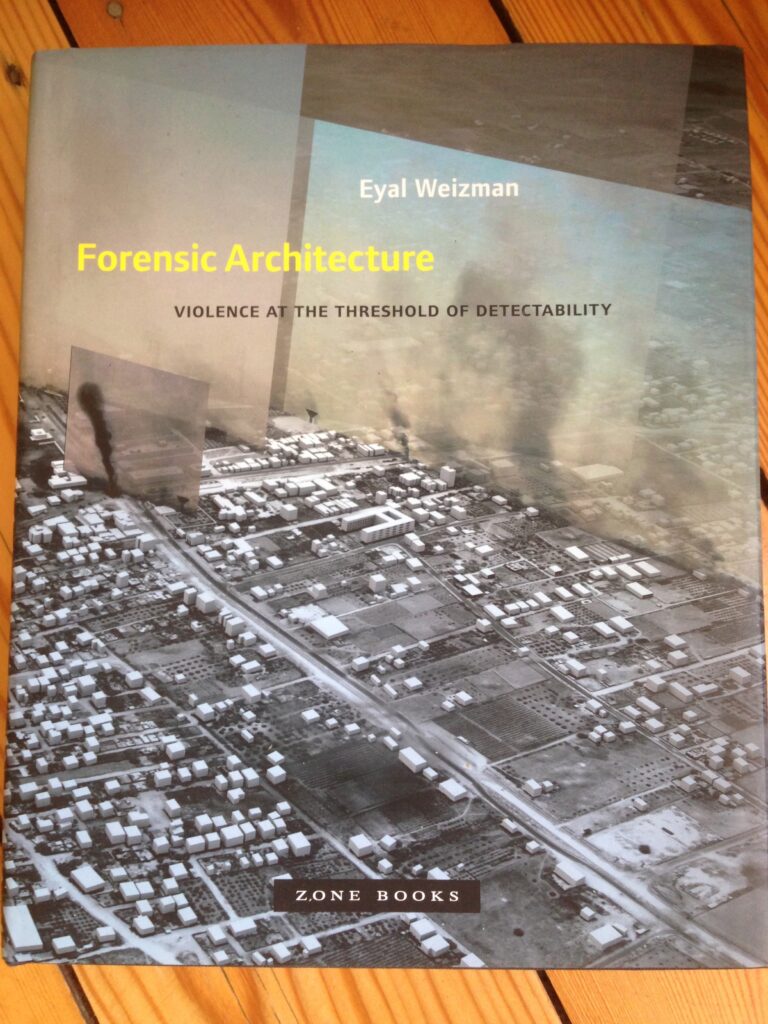
Forensic, that comes from the Latin word forensis: pertaining to the forum. And that is what Forensic Architecture does: it brings things to the forum. And for those here who followed the seminar on Bruno Latour, that brings them close to the work of the French anthropologist who, in Making Things Public, talks about the first parliament, the Althing in Iceland, as a place where people gather in case of dissent. They gather with a matter of concern. And that is exactly what Forensic Architecture does. They are concerned. Motivations, in the case of Forensic Architecture, are not an obstacle, but a precondition. “Engaged objectivity”, they call that: “to be involved”.
Forensic Architecture attributes a voice to inanimate things. And that again is very close to Latour who looks at things with agency, bringing people and other things together. That is how Forensic Architecture recreates events. They turn a non-event into an event. They detect a form of slow violence that targets life sustaining fields, forests, water sources or infrastructural systems as roads and electric networks: slow violence, that occurs gradually and out of sight. Violence that is imperceptible, unimageable, unimaginable. Turning a non-event into an event is also, in the case of Forensic Architecture, acting against denial – the denial of peoples rights on which authoritarian states are founded.
So, therefore, the most important thing is how Forensic Architecture demonstrates that war is not only fought with guns, tanks and bomber planes, but that there are much more cunning ways to fight a war. The civilian occupation of the settlements is one example. Or the control on goods to be brought in and out of the occupied territories… etc…
Before and After, the title of my lecture comes from a little book by Eyal and Ines Weizman.
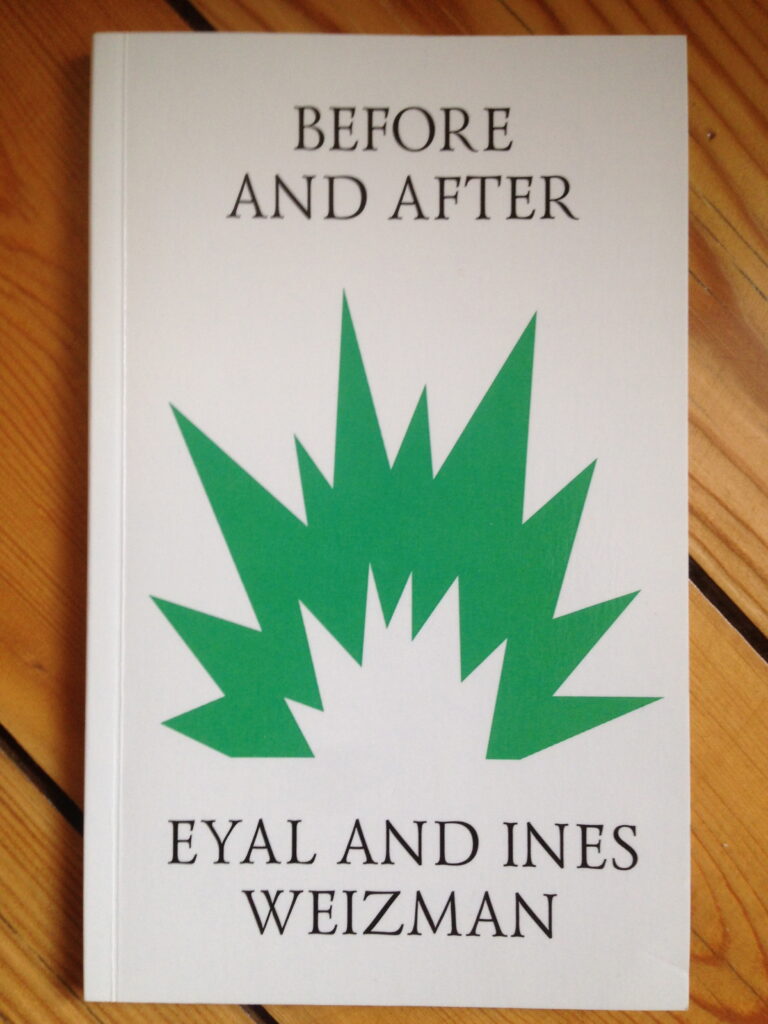
A shorter version of the text with the same title is part of Forensis and of Weizman’s book, Forensic Architecture. In the book Eyal and Ines Weizman trace a history that is as old as the history of photography and that becomes more and more a history of catastrophe. It is a history in which humans disappear from the image to make place for architecture. There are technical reasons for that disappearance: the relatively long time it takes to open the shutter to make a picture in the early days of photography excludes humans and other moving creatures from being photographed. In order to show an event, one needs two images – before and after – to learn about what happened in between. Similar technical limitations play today in the satellite images that are used to capture an event. Not only are these images for security reasons limited to 50 cm. per pixel (in Israel it is even 1 metre per pixel), which excludes humans from being photographed and leaves only architectural structures to remain visible. But also, it takes a satellite at least 90 minutes to orbit around the world and come back to the place of the first photograph. That way, images of architecture, objects, infrastructure add to the testimony of the witness in the reconstruction of an event.
And this is what you have to understand about Forensic Architecture. While giving a voice to things they go back to the people who were there before and after, but also during the event. And this is so important about their work: that, through architecture, they bring people back into the picture. Palestinian writer Elias Sanbar did the same thing retracing the history of Palestine through the history of photography.

A history of catastrophe, indeed. Technical limitations kept people out of the picture. But there is more than that of course. What is also important is who made these pictures. It were European photographers who had access to the technology and the chemicals to make the photos: tourists, orientalists, coming as early as in 1839, the year photography was invented, to the Holy Land guided by the Bible searching for the same image, the same idea, over and over again. As if nothing changes: a history of the non-event to establish the permanent presence of the Bible in this land. It takes until the end of the 19th century until Palestinians own the means to make their own pictures and start photographing their own land with their own people, to disappear again in 1948, with the Nakhba: the catastrophe. They return soon after in the photos of the UNRWA, the United Nations Relief Agancy for Palestinian Refugees in the Middle East. The UN has to do that to document their work (and not so much to document the fate of the Palestinian refugees). In the 1960’s we get the first images of the Fedayin and the PLO fighters who want to be seen different, not as victims, but as heroes. It will take until the end of the 1980’s with the first Intifada to see again photos of Palestinians in Palestine, or to see the drowned country return to the surface. But the most striking thing about this book is that there are very few images of the major event: the Nakhba – the catastrophe of 1948.

This is one of the nine images that Sanbar could find to show in the book. All other photos are made before, or after. And that is what we have to work with to get the stories of these people back into the picture.
Fort Beau, December 2019